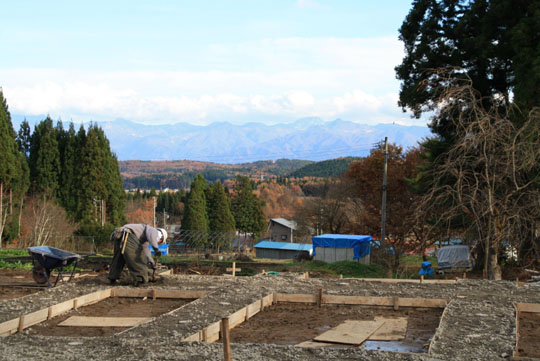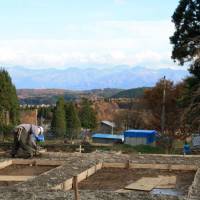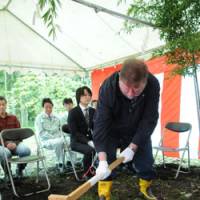Over the last 22 years we have had many guests visiting our woods up here in the Kurohime hills of Nagano Prefecture. However, their numbers have shot up since we converted our holdings into being The C.W. Nicol Afan Woodland Trust in 2002.
Up until now, guests have been entertained in the humble hut of our forester, Mr. Matsuki, seated on a couple of low benches with a woodstove between and Mr. Matsuki enthroned on a raised tatami dais surrounded by bear and raccoon-dog skins, tools, pots, packets of biscuits and chocolate — and whatever else he feels he needs to be able to just reach out and grab.
He reaches to his right and takes a jar of tea leaves and a tea pot. He brews tea from a kettle of hot water always on the stove. He reaches again into a basket of cups, pouring tea for himself and each guest. The Japanese cups, far too hot to hold, are put on logs that act as little tables. Then, cross-legged, Mr. Matsuki starts to pontificate on the world at large, or to relate outrageous hunting, fishing and logging stories.
Nobody else can get a word in edgeways, and six guests in the hut make it crowded so that any others have to sit outside. Lucky ones get fed wild-mushroom soup, bear or wild boar stew — or once in a while oden (a hot broth with chunky ingredients). Very tasty it is too, although the service is somewhat on the primitive side.
We also have what I call a "sound shelter" deeper in the woods. This is a strongly built, wooden open-fronted lean-to shelter roofed with cedar bark. In front of it there's a fireplace whose curved stone retaining wall reflects heat into the shelter.
As my name for it suggests, the shelter is designed to catch sound, acting like a big ear. I sometimes take a sheepskin rug, a sleeping bag, cooking utensils, food, candles and something to drink and stay there overnight. A few people can also be entertained there, even in bad weather, but comfortably, no more than eight.
Despite such rude luxuries in our woods, however, I have for several years felt the need for a place where we could hold small seminars, and gather in as many as 50 people for a buffet-style lunch, or 30 guests for a sit-down dinner.
With this in mind, we managed to raise the money and our new center — or clubhouse — has been architect-designed. It will accommodate the offices of the trust, a place for simple day-to-day business meetings, a large kitchen in which we will be able to grill with charcoal from our woods, and then a hall. The hall will have a large stone fireplace and a high-beamed roof, and will be equipped with a big flat screen so we can show what goes on in the woods when humans are not present via live telecasts from cameras positioned out there.
Last year, too, we were able to harvest hardwoods (leaving the best trees, of course) to make traditional tables and chairs to furnish the center, in whose construction and furnishing all the lumber and stone used will be Japanese.
Meanwhile there will also be a small apartment for VIP guests, and what the architect calls a "study" for the chairman. (For "study," read "my private bar"). This upstairs getaway will have a wood stove.
The building itself is to be situated on a patch of land I bought about 26 years ago that now adjoins the woods. It had a small derelict farmhouse and an overrun garden with a big chestnut tree. We've kept the tree, but cleared the rest. I never ever had any intention of cutting down part of the woods for a building site, so this place, with an excellent view of the Shiga range and Mount Reisenji, Mount Iizuna and Mount Kurohime behind is perfect.
In Japan, before construction, a ceremony to placate the kami, or gods, is a must. This is known as a jichinsai — a kind of elaborate groundbreaking ritual.
The head priest from the Benten Islet shrine on Nojiri Lake here in Nagano Prefecture came to officiate. A large tent was set up, with an altar at one end upon which were placed offerings of salt, rice, sake, fish, dried kelp, and fresh fruit and vegetables, decorated with bamboo and the evergreen sakaki (Cleyera ochnacea or Theacea japonica). To one side in front of the altar there was also a cone of sand, like a little mountain, with a few small leafy branches stuck in the top.
The priest invoked the gods, and read out for their benefit an account of what construction was to be carried out, and by whom, asking for understanding and blessing. He performed the purification ritual of harai, swishing a wand covered with paper streamers over the altar, the people standing with bowed heads, and the ground. While his chanting continued, that day a crow accompanied him with rhythmic caws from the top of a tall cedar tree nearby.
The architect was called out and handed a ceremonial sickle, with which he pretended to cut the stems of the plants on the cone of sand. Three cuts, crying "Eh! Eh! Eh!" each time. Then I was called and presented with a ceremonial mattock. I swung at the sand three times, also venting the three "kiai" shouts. Lastly, the head of the construction company was called and presented with a ceremonial spade. He dug three times, while also crying out, at the cone of sand.
Consequently, in this ancient way, and presumably with the permission of the gods — even though we had disturbed the land by cutting grasses, breaking ground, and digging — the spirits were calmed.
We three wielders of tools and disturbers of ground were then handed sprigs of sakaki that we laid on the altar, bowing and clapping. Lastly, everybody present was handed a small, shallow white dish of sake with which to raise a toast.
I am not a religious man and was raised as a Christian, but this ritual strangely moved me. Although the ceremony started out under dark gray clouds and amid spatters of rain, halfway through it blue sky appeared and the sun shone brightly on us.
I doubt if any of the construction workers were particularly superstitious, but there was no questions as to whether or not the ceremony should be performed. Construction can be dangerous, and they would insist on a ji chin sai. I felt very much at ease and filled with confidence for the future of our center — or "clubhouse for members" — and I look forward to it being completed sometime next summer.





